A mother’s intuition: Persistence leads to positive outcomes for Hudsyn
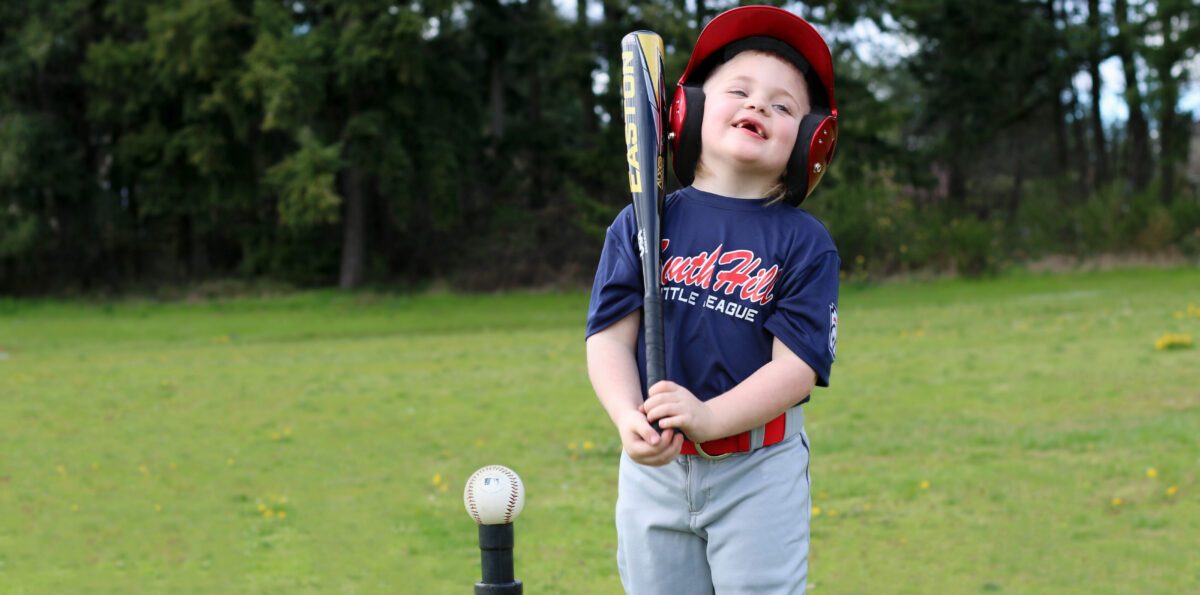
Hudsyn may only be 4 years old, but he’s an old soul, according to his mom.
“He’s four going on 44,” says his mom, Brittany.
In addition to his love for things like morning coffee with his grandma or deep conversations with his family, Hudsyn loves things that most other kids do: Playing sports, throwing balls, running and playing with his older brother. Most recently, he’s discovered a love for playing T-ball.
Brittany is amazed at Hudsyn’s progress. This time last year, he was in the Mary Bridge Children’s pediatric intensive care unit (PICU) recovering from brain surgery and going to physical therapy multiple times every week.
In his young life, Hudsyn has relearned how to walk three times.
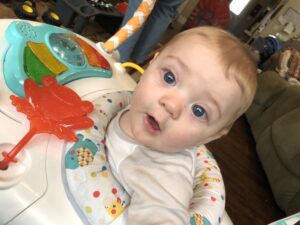
Hudsyn as a happy and smiley infant
Hudsyn was born healthy and happy, but his mom noticed one of his feet was turned inward and seemed weaker than the other when he was about 9 months old. Doctors at other health systems — and even Brittany’s family — tried to encourage her by telling her everything was OK, that all kids are different, and his foot would fix itself with time.
At an appointment at Mary Bridge Children’s affiliate Woodcreek Pediatrics, Hudsyn’s pediatrician suggested he start physical therapy, get an X-ray to rule out hip dysplasia and have lab work done to check for other abnormalities.
“That X-ray returned normal,” says Brittany. “But his bloodwork was abnormal, and that’s when we were sent to Mary Bridge for a consult with neurology.”
Meeting Mary Bridge Children’s pediatric neurologists
Hudsyn saw Anisha Schwarz, MD, pediatric neurologist at Mary Bridge Children’s Hospital.
“We loved Dr. Schwarz and learned so much,” Brittany says. “She was concerned about the possibility of a neuromuscular problem and wanted to find the cause of Hudsyn’s low muscle tone, so she ordered some genetic tests.”
In addition to low muscle tone, Hudsyn began suffering from migraines and became increasingly uncoordinated, falling upwards of 20 times a day.
“He had bruises all over because he was constantly falling down,” his mom remembers. “We re-ran Hudsyn’s labs with Dr. Schwarz, and they showed that his creatine kinase (referred to as a CK panel) levels were already much higher than they were just a few weeks prior with our pediatrician.”
“Creatine kinase is an enzyme that is released when muscles break down, but finding the cause requires analyzing patterns of these levels,” says Dr. Schwarz, “For Hudsyn, his exam and pattern of symptoms meant an evaluation including neuromuscular testing and an MRI of the central nervous system.”
A few months later when Hudsyn turned 2, he was able to get a brain MRI. It revealed syringomyelia, a type of fluid-filled cyst that grows within the spinal cord and can impact nerves in the extremities, as well as explain symptoms like sudden migraines and muscle weakness.
After this discovery, Ron Grondin, MD, pediatric neurosurgeon at Mary Bridge Children’s, joined Hudsyn’s care team.
“We met with Dr. Grondin, and he explained the results to us, including how Hudsyn wasn’t getting enough spinal fluid due to the cyst,” Brittany says.
Not one, not two, but three brain surgeries
In March 2021, Hudsyn underwent his first brain surgery. It was uneventful and his headaches lessened, but didn’t resolve.
Because of the operation, Hudsyn had to relearn how to walk. He spent many days in physical therapy at Mary Bridge Children’s Therapy Services – Puyallup, where he regained strength and mobility.
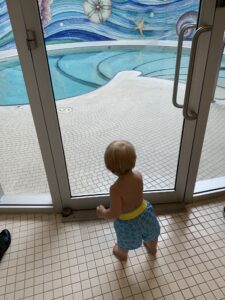
Hudsyn getting ready for water therapy at Children’s Therapy Services – Puyallup
Because of the COVID-19 pandemic, it took a while for Brittany to get Hudsyn in for a follow-up brain MRI. When he had one in January 2022, it showed his brain was doing OK, but the cyst was still causing issues with fluid drainage.
In March 2022, a year after his first surgery, Hudsyn went into surgery again — this time to place drains in his spinal cavity.
“He came back with a giant scar from the base of his skull near the C2 vertebrae, all the way to his C7 vertebrae,” Brittany says.
Once again, Hudsyn had to go to physical therapy to relearn how to walk. But a few months later, his migraines returned.
“There was one week when we were at the hospital three times because we couldn’t control his headaches at home,” Brittany says. “I had to call 911 because he was laying on the couch, completely asleep but screaming in pain, grabbing his head.”
Once he arrived at Mary Bridge Children’s emergency department, Hudsyn went through a shunt screening. Even though he didn’t have a shunt, this screening was helpful to show if anything was wrong with the drains placed in his previous surgery.
“They discovered the drain catheters were looping up like pigtails — they weren’t where they were supposed to be, where Dr. Grondin placed them,” Brittany says.
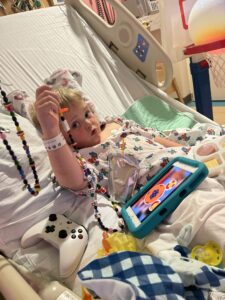
Hudsyn showing off his Beads of Courage during one of his admissions at Mary Bridge Children’s
“Throughout the course of Hudsyn’s care, I went from feeling confident to feeling helpless that I wasn’t able to help him,” says Dr. Grondin. “His parents were patient and understanding with me and Hudsyn’s faith in me gave me the confidence that I needed to help him and others in the same situation.”
In June 2022, Hudsyn was wheeled back for his third brain surgery.
“That’s a lot of surgeries for anyone, but it’s really a lot when he’s only 4 years old and when they’re operating on his brain,” says his mom.
Being the trouper that he is, Hudsyn worked hard at physical therapy to relearn how to walk for the third time in 18 months. Last summer, he was finally cleared to run and play sports.
“Dr. Grondin told us that Hudsyn was the first patient he’s operated on three times,” Brittany says.
Hudsyn wears that distinction like a badge of honor.
“Dr. Grondin is Hudsyn’s favorite doctor, ever,” says his mom. “They really formed a special relationship, and we joke that it’s because Hudsyn is his special patient who needed three brain surgeries.”
Bonds that can’t be broken
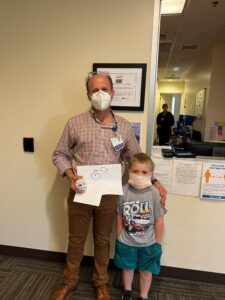
Hudsyn making a special visit to Dr. Grondin to give him a baseball and artwork
“When Dr. Grondin told us that everything looked great and we didn’t need to come for any more appointments, Hudsyn came home crying because he was devastated that he couldn’t see Dr. Grondin anymore,” Brittany says.
While most patients would welcome the reprieve of hospital visits and doctor’s appointments, Hudsyn took it hard.
“He always asks if Dr. Grondin can be his doctor for everything, everything from surgeries to shots,” his mom says with a laugh.
After three operations and many months of intense physical therapy, Hudsyn graduated from all his appointments in December 2022. It’s an incredible achievement, but it doesn’t stop Hudsyn from thinking about Dr. Grondin.
“He enjoys playing with his doctor kit and pretends to dress and act like Dr. Grondin,” Brittany says. “He even drew pictures for him and sent them with a Christmas card because he really, really misses him.”
Today, Hudsyn has recovered and, unless something recurs with severe headaches or balance issues, he’s free from follow-up visits. Now he spends his time enjoying preschool and playing on a T-ball team, where his favorite thing is throwing the baseball and running in the field with his friends.
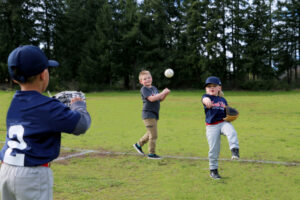
Hudsyn at T-ball practice with his brother and a teammate
Some days it’s hard for his mom to wrap her mind around everything that’s happened, especially when she reflects on where Hudsyn is today compared to just a few months ago.
“When he’s not feeling well or gets an occasional headache, he’ll say to me, ‘Maybe it’s time to go back and see Dr. Grondin,’” Brittany says. “Hudsyn is so self-aware, and I always ask if his headache is bad enough to need to go to the hospital, or if he just needs some Tylenol. So far, he’s only needed the medicine, but the way that he thinks about Dr. Grondin just speaks volumes to the impact that Dr. Grondin has had on his young life.”
“Sometimes, I believe that I get much more from my patients than I can ever return to them,” says Dr. Grondin. “But patients like Hudsyn make me always want to try harder and never give up.”
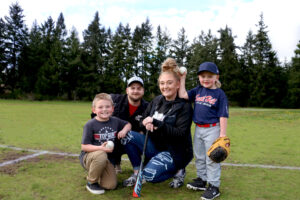
Hudsyn (right) with his family at his T-ball practice
Mary Bridge Children’s is dedicated to providing patient-first, family-centered care for all children using a multidisciplinary approach, including primary care, urgent care, specialty care and therapy services. Find a provider near you or learn more about the Mary Bridge Children’s experience.